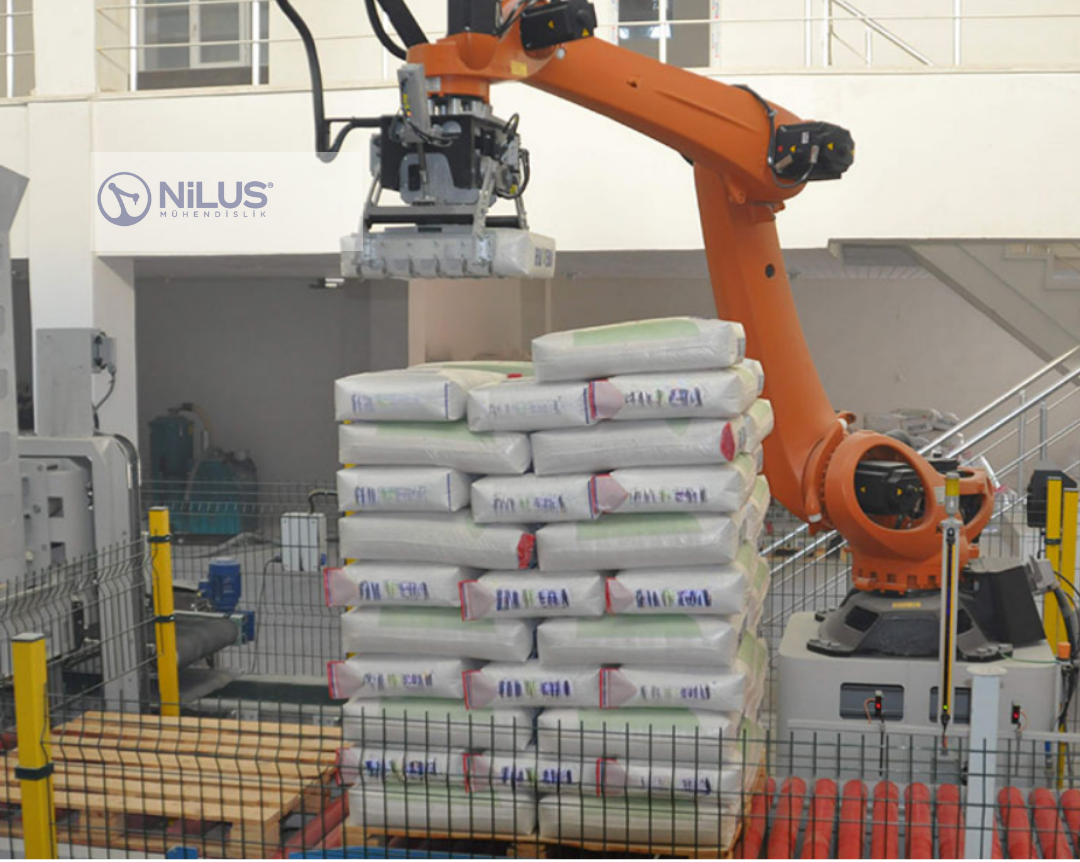Hello Dear Readers;
Today we take an in-depth look at palletizing robots. In today’s industry, improving efficiency and reducing costs is more important than ever. At this point, palletizing robots provide great advantages to businesses by revolutionizing production processes. In this article, we will examine in detail the 7 surprising advantages offered by palletizing robots and how this technology is transforming the industry.
What are Palletizing Robots?
Palletizing robots are advanced machine systems that automatically place products on pallets at the end of production lines. These robots can precisely transport products of different sizes and shapes, optimize stacking operations and significantly speed up logistics processes.
History of Palletizing Robots
The development of palletizing robots is an important part of the history of industrial automation. Although the first palletizing robots appeared in the 1980s, these systems have become much more sophisticated in recent years with advances in artificial intelligence and sensor technologies.
7 Surprising Advantages of Palletizing Robots
1. Massive Increase in Productivity
Palletizing robots can work much faster and without interruption than human workers. These robots can continue operations 24 hours a day without a break, thus significantly increasing the efficiency of production lines.
For example, up to 30% increases in productivity have been observed as a result of the use of palletizing robots in a medium-sized production facility.
2. Improvement in Occupational Safety
The palletizing process can be risky for workers due to lifting and moving heavy loads. Palletizing robots undertake this dangerous task, reducing occupational accidents and making the working environment safer.
For occupational safety statistics, check out the International Labor Organization report:
Approximately 3 million people lose their lives due to work accidents and occupational diseases | International Labor Organization (ilo.org)
3. Consistent Quality And Precision
Errors caused by human factors are minimized thanks to palletizing robots. These robots work as programmed with the same precision every time, thus reducing product damage and improving palletizing quality.
4. Cost Savings
Although the initial investment is high, palletizing robots provide significant cost savings in the long run. Reducing labor costs, decreasing wastage rates and energy efficiency are some of the economic advantages provided by these robots.
5. Flexibility And Adaptability
Modern palletizing robots can quickly adapt to different product types and sizes. This flexibility allows production lines to respond more quickly to changing market demands.
6. Data Analysis and Traceability
Palletizing robots collect detailed data about operations. This data can be used to optimize production processes and increase traceability in supply chain management.
7. Environmental Sustainability
Palletizing robots contribute to more sustainable production processes by optimizing energy consumption and reducing material waste. This helps businesses reduce their carbon footprint.
For more information about industrial sustainability, click:
https://www.unido.org/our-focus-safeguarding-environment
How Do Palletizing Robots Work?
Palletizing robots work using complex algorithms and advanced sensor systems. Here are the basic working principles:
Product Recognition: Cameras and sensors recognize the size and shape of incoming products.
Motion Planning: The robot calculates how to place the product most efficiently.
Gripping and Transport: The product is grasped and carried with specially designed grippers or vacuum systems.
Placement: The product is placed precisely on the pallet according to the predetermined pattern.
Stacking Optimization: The robot optimizes the stability and space utilization of the pallet.
Impact of Palletizing Robots on Industries
Palletizing robots are creating revolutionary changes in various industries. Here are some examples:
Food And Beverage Industry
Hygiene and speed are very important in the food and beverage industry. Palletizing robots increase production speed while reducing the risk of contamination. For example, packaging efficiency increased by 40% as a result of the use of palletizing robots in a milk processing plant.
Automotive industry
Moving and stacking heavy parts is a critical process in the automotive industry. Palletizing robots increase the capacity of production lines by making this task safer and more efficient.
Pharmaceutical Industry
Precision and traceability are very important in the pharmaceutical industry. Palletizing robots ensure that each product is handled and tracked accurately.
E-Commerce and Logistics
Increasing online shopping trends have increased the demand for palletizing robots in logistics centers. These robots ensure fast and accurate processing of orders.
Read more about e-commerce logistics
Blog for Growing & Enterprise Commerce Brands – Shopify
The Future of Palletizing Robots
Palletizing robot technology continues to develop rapidly. Here are some trends expected in the future:
Artificial Intelligence Integration: Robots will be able to perform more complex tasks with smarter decision-making mechanisms.
Collaborative Robots: Cobots, which increase human-robot cooperation, will be used more widely in palletizing processes.
IoT and Industry 4.0 Integration: Palletizing robots will be fully integrated into the smart factory ecosystem.
Energy Efficiency: Robots that consume less energy and are more sustainable will be developed.
Mobile Palletizing Robots: Instead of fixed stations, robots that can move in the production area will become widespread.
Challenges Encountered in the Application of Palletizing Robots
In addition to the advantages of palletizing robots, some difficulties may arise in practice:
High Startup Cost: The initial investment cost can be a deterrent, especially for small businesses.
Technical Expertise Requirement: Specially trained personnel are required to install and maintain robots.
Flexibility Limitations: For some specialized products or complex palletizing patterns, robots may be inadequate.
Employee Resistance: Fear of job loss due to automation can create resistance among employees.
To overcome these challenges, businesses must conduct a detailed cost-benefit analysis and implement new skills acquisition programs for their employees.
Things to Consider When Choosing Palletizing Robots
Choosing the right palletizing robot for your business is critical. Here are some factors you should consider:
Capacity and Speed: The robot’s throughput and speed must meet the requirements of your production line.
Flexibility: The ability to work with different product types and sizes is important.
Ease of Integration: It should be compatible with your existing systems.
Security Features: Compliance with the latest security standards is a must.
Service and Support: A reliable vendor and a good support network should be chosen.
Total Cost of Ownership: Not only the initial investment but also long-term operating costs should be evaluated.
Palletizing Robots and Their Effects on the Workforce
The proliferation of palletizing robots has significant impacts on the labor market. These effects can be both positive and negative:
Positive Effects:
New Job Areas: New job positions such as robot operator and maintenance technician emerge.
Occupational Safety: Delegating dangerous and repetitive tasks to robots reduces occupational accidents.
Increased Productivity: Employees can focus on more strategic and creative tasks.
Conclusion
Palletizing robots are creating a revolutionary change in modern production and logistics processes. This technology increases efficiency, reduces costs, improves occupational safety and provides businesses with a competitive advantage. However, careful planning, correct robot selection and employee training are critical for a successful implementation.
In the future, it is anticipated that palletizing robots integrated with technologies such as artificial intelligence and IoT will further develop and play a more central role in industrial processes. By keeping up with this technological transformation, businesses will be able to remain competitive in changing market conditions.
Palletizing robots are shaping the future of industrial efficiency and becoming an important component of Industry 4.0. Businesses that invest in this technology will not only cope with today’s challenges, but will also be ready for the opportunities of the future.
As palletizing robots continue to revolutionize manufacturing, it is critical for businesses to embrace and strategically apply this technology for sustainable growth and success.






